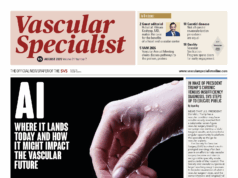 Five-year data from the ACST-2 trial comparing carotid endarterectomy and carotid artery stenting, a report from the Crawford Forum at the 2021 Vascular Annual Meeting (VAM), and an Eastern Vascular Society (EVS) annual meeting piece reporting on vascular surgery as a healthcare system’s “enabling service” were among the most-read stories on the Vascular Specialist website in September.
Five-year data from the ACST-2 trial comparing carotid endarterectomy and carotid artery stenting, a report from the Crawford Forum at the 2021 Vascular Annual Meeting (VAM), and an Eastern Vascular Society (EVS) annual meeting piece reporting on vascular surgery as a healthcare system’s “enabling service” were among the most-read stories on the Vascular Specialist website in September.
1. Five-year ACST-2 results: Carotid artery surgery and stenting have similar long-term effects on stroke
Carotid artery surgery and stenting have comparable long-term effects on fatal or disabling stroke in asymptomatic patients with severe carotid artery stenosis. That was the finding of late-breaking ACST-2 data presented in a Hot Line session at the European Society of Cardiology’s 2021 congress.
2. New SVS vice president: ‘How do vascular surgeons differ? We provide comprehensive vascular care’
In a video interview, Society for Vascular Surgery (SVS) Vice President Joseph Mills, MD, talked to Vascular Specialist about how inclusivity is at the forefront of SVS diversity and equity efforts; the benefits of global collaboration in the treatment of vascular disease; his approach to social media outreach; the concept of comprehensive vascular care; and how to optimize care for the diabetic foot patient population.
3. EVS 2021: Vascular surgery as ‘an enabling service’ for the wider healthcare system
Vascular surgery is as important as anesthesia in providing a safe operating room (OR), Richard Powell, MD, the vascular section chief at Dartmouth-Hitchcock Medical Center in Lebanon, New Hampshire, told an Eastern Vascular Society (EVS) annual meeting (Sept. 23–26) issues panel.
4. SVS announces future launch of vascular verification program, aiming to enhance quality improvement
The Society for Vascular Surgery (SVS), in partnership with the American College of Surgeons (ACS), announced the future launch of a program to verify quality on the part of facilities that offer vascular care.
5. ‘Do we need to do a better job of making devices that fit female anatomy?’
It was a burning question posed from the VAM conference floor, and it led to some approving social media nods in its aftermath: Does the tone of conversation around the vascular anatomy of females need to morph into a discussion about the availability of devices that fit the female anatomy?
6. Vascular Specialist–September 2021
In our September issue, we took a closer look at the at the latest signal around paclitaxel-coated balloon (PCB) use in patients with peripheral arterial disease (PAD) through the prism of five leading vascular surgeons. We also covered structural changes made to the 2021 VAM and the new SVS appropriate use criteria (AUC) covering intermittent claudication.
7. MVSS 2021: Midwestern Vascular unveils 2021–22 leadership changes
The Midwestern Vascular Surgical Society (MVSS) announced a new slate of officers at its 2021 annual meeting held in Chicago from Sept. 9–11. Raghu Motaganahalli, MD, officially assumed the reins as MVSS president for 2021–22, taking over from Kellie Brown, MD, who led the society for a two-year term following the outbreak of the COVID-19 pandemic.
8. ‘Tremendous advances in imaging possibilities’ signal further innovation, says leading vascular chief
It was a complex repair in the thoracoabdominal region of the aorta around 10 years ago, and Matthew Eagleton, MD, and his surgical team were in the process of cannulating several target vessels. They were being guided by what, for the period, was state-of-the-art imaging technology. When the chief in the division of vascular and endovascular surgery at Massachusetts General Hospital in Boston looks back on the overlay image—a computed tomography (CT) scan—now, he almost balks.
9. VAM discussion on latest paclitaxel meta-analysis yields mix of caution, skepticism
A VAM sponsored session on paclitaxel safety drew a mix of skeptical and cautious responses to the latest meta-analysis from interventional radiologist Konstantinos Katsanos, MD, that reported a heightened risk of major amputation after use of paclitaxel-coated balloons (PCBs) in femoropopliteal and infrapopliteal arteries.
10. ‘Proceed cautiously in use of DCBs in CLTI patients with advanced WIfI stage’
Michael Conte, MD, and Joseph Mills, MD, discuss the ongoing controversy and debate about the risks and benefits of paclitaxel drug-coated balloons (DCBs) in the context of the latest contribution from Katsanos.












